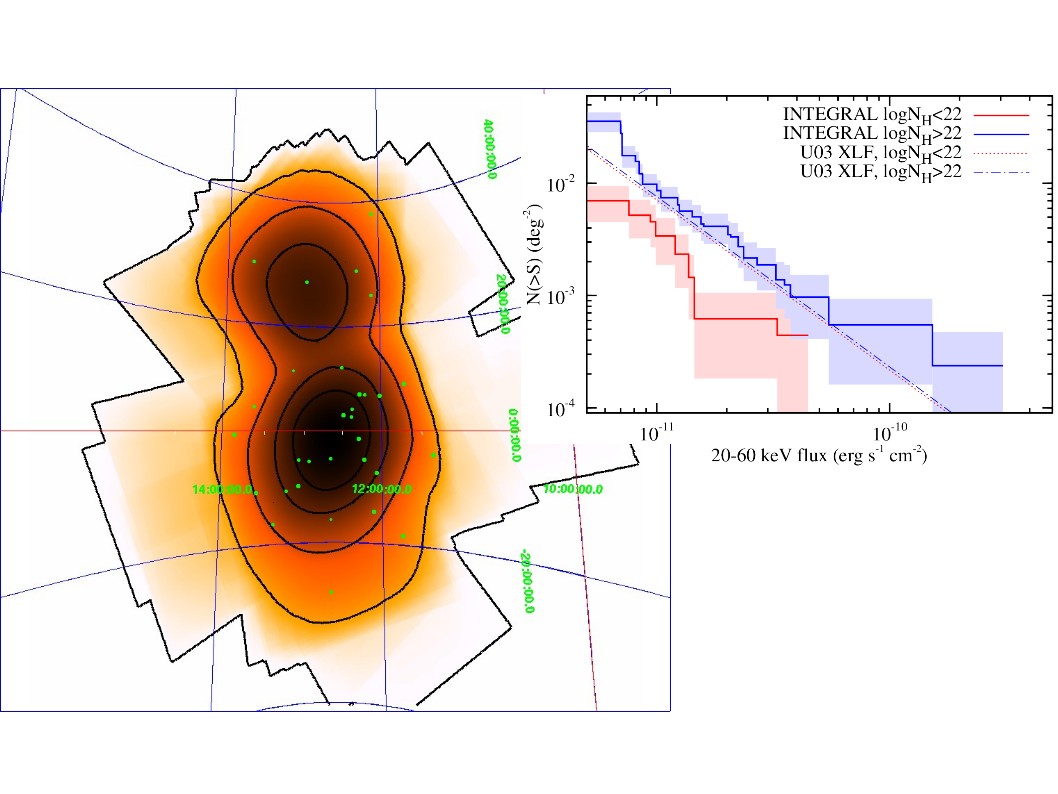Extragalactic Astronomy - INTEGRAL
Extragalactic Sources
|
The cores of many galaxies produce enormous amounts of radiation at all wavelengths. These Active Galactic Nuclei or AGN are assumed to be fueled by accretion of matter onto supermassive black holes with 106 to 1010 solar masses. The high energy emission is thought to be released in a corona of hot material above the accretion disk, and/or in powerful jets. Another source of X-ray and gamma-ray emission can be the hot gas permeating galaxy clusters. |
 |
 |
Deep Surveys and the high-energy backgroundDue to its wide field of view, INTEGRAL is able to observe large fields of the extragalactic sky at once and thus to undertake very deep surveys of the sky (up to several Msec) at energies which allow to pierce through normal gas and dust layers, shrouding some sources from observations in the classical X-ray range. These surveys find new sources many of them absorbed sources, as expected to explain the high-energy background radiation at these energies. But they do not find as many as predicted, hinting at sources which are even more enshrouded ("Compton-thick") or an evolution of source properties. See, e.g., Paltani et al. (2008), Sazonov et al. (2007), Beckmann et al. (2006), or Bassani et al. (2006). |
  |
Using the Earth to measure the cosmic backgroundIn January and February 2006, INTEGRAL undertook an original approach to observe the contribution of unresolved sources to the high-energy background - use the Earth to block the radiation of the diffuse high-energy background to measure its strength and spectrum with higher precision than ever before in the range where its contribution is strongest. The observations were complex, fixing the satellite's observing direction of the sky and letting Earth drift through the field. The results have been published by Churazov et al. (2007). |
 |
The Ophiuchus Galaxy Cluster as particle acceleratorThe Ophiuchus cluster of galaxies is a bright X-ray source, but in the past it was unclear if there was an additional non-thermal spectral component or not. Combining 3 Ms of INTEGRAL data, Eckert et al. (2008) clearly detected the high-energy tail and show that this excess emission cannot come from very hot regions or absorbed AGN. There are two models to explain the emission, one by inverse-Compton scattering of GeV electrons on CMB photons, one by synchroton radiation of an electron population at TeV energies, which then should be detectable, e.g., by HESS. |
 |
Across the universeMany of the sources found by INTEGRAL are not immediately identified, awaiting observations at other wavelengths. In the case of the INTEGRAL source IGR J22517+2218 an observation by NASA's Swift satellite permitted the identification with the already known active galaxy MG3 J225155+2217, a blazar at redshift z~3.668. Thus making it the furthest celestial object ever to be observed by INTEGRAL (see Bassani et al. 2007). |
 |
Probing large scale structure of the local universeIt is widely accepted that practically every galaxy in the local Universe harbors a supermassive black hole and some of these black holes are visible as AGNs with different luminosities. Therefore, the volume number density of X-ray emitting AGNs is proportional to the volume number density of galaxies. Based on their hard X-ray all sky survey, probing the local universe up to ~100 Mpc, Krivonos et al. (2007) show that the AGN volume density is indeed strongly inhomogenous, reflecting the large-scale structure in the local Universe. |
- Removed a total of (2) style text-align:center;
- Removed a total of (5) style float:left;








































 Sign in
Sign in
 Science & Technology
Science & Technology